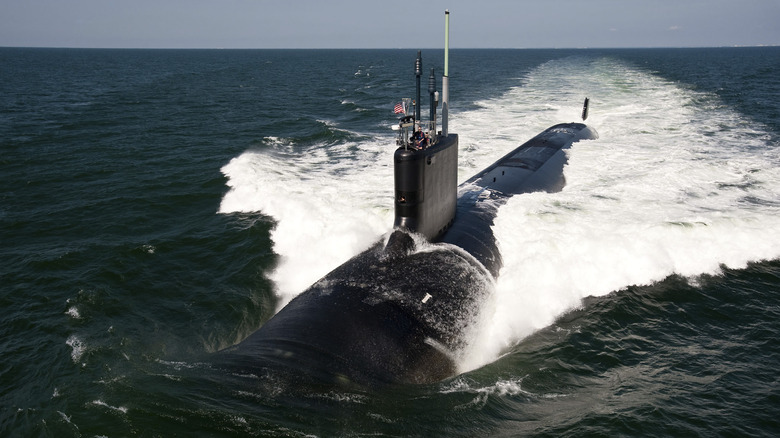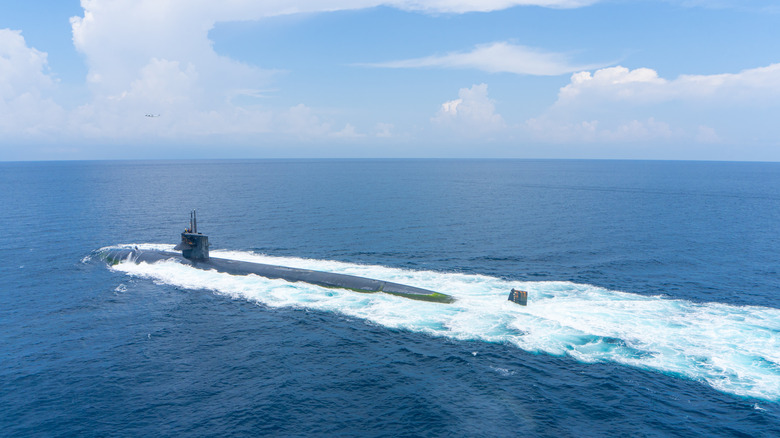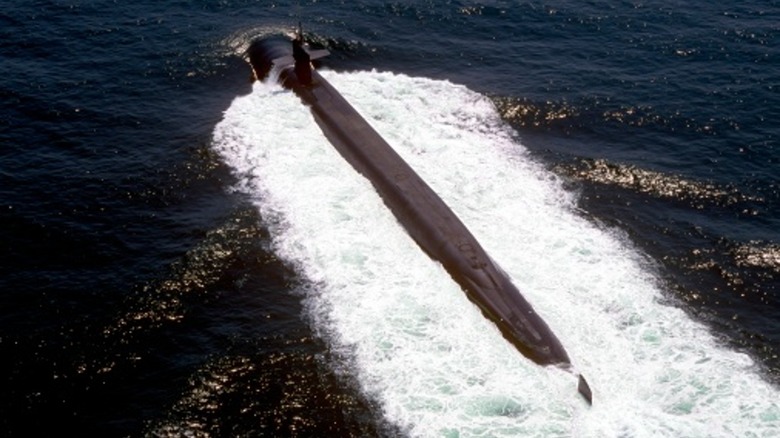Ballistic Missile Submarines Vs. Attack Submarines: What's The Difference?
To the uninitiated, it might seem like if you've seen one submarine, you've seen them all. After all, movies like "Crimson Tide" and "The Hunt for Red October" kind of show all subs performing the same actions. They submerge, launch torpedoes at other subs, and then go back to port after a job well done.
Submarines built during World War II were all primarily designed to attack adversarial submarines and surface ships. There wasn't much difference between their missions. However, the creation of nuclear power changed everything, and America quickly started developing a deterrent program. This included its fleet of submarines: First, America developed submarines that could launch guided missiles, starting with the USS Cusk (SS/SSG-348) in 1947. Then, there was the first nuclear-powered submarine (USS Nautilus SSN-571) in 1954.
1959 brought about a split in missions for submarines because that was when the United States Navy developed the USS George Washington (SSBN-598), the first nuclear-powered ballistic missile submarine. Now America's surprisingly large submarine fleet is comprised of more than just a variety of classes, but varying sized submarines with very different objectives as well. It's not wrong to say that fast attack subs and ballistic missile submarines have many of them same basic features. They all have an attack center (or bridge), a sonar room, and a nuclear reactor, among other similarities, but their naval capabilities vary.
Attack submarines are designed for swift incursions
Fast attack submarines have a number of missions, unlike their ballistic missile counterparts. Attack submarines (SSN) need to be fast, thus the unofficial moniker "fast attack," which is why they typically travel over 25 knots. They need to be able to catch up to their target, whether it's another submarine or surface ship, and then get away quickly. When targeting other submarines, American attack subs will use Mk-48 torpedoes, but they can also launch Tomahawk cruise missiles against other targets. On top of that, attack subs can also be outfitted with equipment to perform surveillance and reconnaissance missions.
The United States Navy has at its disposal three attack submarine classes. There's the 25 (down from 62) aging Los Angeles-class, three Seawolf-class, and the newest and most advanced Virginia-class submarine. There are currently 22 commissioned Virginia-class submarines with a plan for a total of 38 to be built, gradually replacing the Los Angeles-class as they retire. It's outfitted with Mark 48 torpedoes and Tomahawk missiles like its sibling subs, but it's designed for a variety of missions, giving it access to Mark 60 CAPTOR mines, advanced mobile mines, and unmanned underwater vehicles, along with a torpedo room that can be reconfigured to fit a variety of personnel and gear.
Unlike ballistic missile submarines, SSNs need to be smaller, so they're not typically longer than 400 feet. Los Angeles subs are 360-feet long, and Virginias are 377-feet. Seawolfs are only 353-feet long — except the USS Jimmy Carter (SSN-23), which was modified to be 100-feet longer.
Ballistic missile submarines serve as silent, distant fighters
Unlike their counterparts, ballistic missile submarines (SSBN) — more commonly referred to as "boomers" — are larger and designed to remain undetected in the depths of the world's oceans. These are the vehicles that attack submarines might hunt if the need arises. They serve as a stealthy and mobile launch platform of nuclear warheads, ensuring strategic insurance against nuclear-armed adversaries. American Ohio-class boomer submarines can carry 20 ballistic missiles (SLBMs) that can each be armed with multiple nuclear warheads. They're not without their defenses, though, as they come armed with MK-48 torpedoes, too.
Ohio-class subs are 560-feet long, have a diameter of 42-feet, and displace 18,750 tons when submerged , and can travel more than 25 knots. The new Columbia-class boomers, successor to Ohio-class subs, are even larger with a displacement of 20,810 tons when submerged and a 43-foot diameter. However, it's just as long as its predecessor at 560-feet, only carries 16 Trident II D5 missiles, and is only capable of roughly 20 knots.
Ballistic missile subs are capable of staying out at sea for extended periods of time. They typically spend 77 days at sea before returning to port for 35 days. During the sub's time in port, it will undergo maintenance and replenish supplies. Each boomer also has two crews, Blue and Gold, who alternate patrol shifts. If you can imagine being in a giant metal tube underwater for two and a half months at a time, some time on land is necessary for morale.


